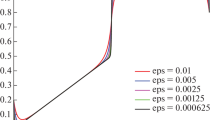We have constructed an algorithm for the asymptotic approximation of the solutions of inverse singularly perturbed boundary-value problems of the convection-diffusion type with unknown diffusion coefficient, depending on the coordinates of a quadrangular curvilinear domain of filtration. The case of sufficient smoothness and consistency of the overdetermination, initial, and boundary conditions is considered. Unlike the construction of an algorithm for the solution of similar problems in doubly connected domains, here, in the corresponding relations, there appear corrections taking into account the influence of “lateral sources of pollution.” With the help of this algorithm, we have carried out a computer experiment, the results of which confirm the well-known fact of “strong sensitivity” of the model to assignment of the overdetermination condition. In particular, we have revealed the specific character of influence of this condition on the required diffusion coefficient depending on the filtration velocity.
Similar content being viewed by others
References
A. Ya. Bomba, “On the asymptotic method for the solution of one problem of mass transfer in the course of filtration in a porous medium,” Ukr. Mat. Zh., 34, No. 4, 493–496 (1982).
A. Ya. Bomba and I. M. Prysyazhnyuk, “Asymptotic expansion of the solutions of singularly perturbed nonlinear boundary-value problems of the convection-diffusion type with delay,” Dopov. Nats. Akad. Nauk Ukr., No. 3, 60–66 (2005).
A. Ya. Bomba, I. M. Prysyazhnyuk, and O. A. Fursachyk, “Inverse singularly perturbed problems of the “convection-diffusion” type for doubly connected domains,” in: Physical and Mathematical Modeling and Information Technologies [in Ukrainian], Issue 8 (2008), pp. 19–25.
A. B. Vasil’eva and V. F. Butuzov, Asymptotic Expansions of the Solutions of Singularly Perturbed Equations [in Russian], Nauka, Moscow (1973).
M. I. Vishik and L. Ya. Lyusternik, “Regular degeneration and boundary layer for linear differential equations with a small parameter,” Usp. Mat. Nauk, 12, No. 5, 3–122 (1957).
A. P. Vlasyuk and P. M. Martynyuk, “Numerical solution of one class of problems that are encountered in the theory of filtration consolidation,” Dopov. Nats. Akad. Nauk Ukr., No. 12, 65–72 (2000).
V. M. Entov, “Filtering theory,” Soros Obrazovat. Zh., No. 2, 121–128 (1998).
M. I. Ivanchov and R. V. Sahaidak, “Inverse problem of determining the highest coefficient in a two-dimensional parabolic equation,” Mat. Met. Fiz.-Mekh. Polya, 47, No. 1, 7–16 (2004).
Methods of the Theory of Singular Perturbations in Applied Problems [in Russian], Intelserv, Riga (1990).
A. I. Prilepko and A. B. Kostin, “On the inverse problems of determining a coefficient in a parabolic equation. II,” Sib. Mat. Zh., 34, No. 5, 147–162 (1993).
S. G. Pyatkov, “Certain inverse problems for parabolic equations,” Fundam. Prikl. Mat., 12, No. 4, 187–202 (2006); English translation: J. Math. Sci., 150, No. 5, 2422–2433 (2008).
R. Schefke, “Inverse problems in the theory of singular perturbations,” in: Proceedings of the International Conf. on Differential and Functional-Differential Equations – Satellite of the International Congress of Mathematicians ICM-2002 [in Russian], (Moscow, Aug. 11–17, 2002), Part 3: Present-Day Mathematics and Fundamental Directions, Moscow (2003), pp. 63–88.
D. G. Aronson, “Linear parabolic equations containing a small parameter,” J. Rat. Mech. Anal., No. 5, 1003–1014 (1956).
L. E. Bobisud, “Parabolic equations wits a small parameter and discontinuous data,” J. Math. Anal. Appl., 26, No. 1, 208–220 (1969).
L. Yang, J.-N. Yu, and Z.-C. Deng, “An inverse problem of identifying the coefficient of parabolic equation,” Appl. Math. Model., 32, No. 10, 1984–1995 (2008).
S. G. Pyatkov, “Solvability of some inverse problems for parabolic equations,” J. Inverse Ill-Posed Probl., 12, No. 4, 397–412 (2004).
A. Shidfar, R. Pourgholi, and M. Ebrahimi, “A numerical method for solving of a nonlinear inverse diffusion problem,” Comput. Math. Appl., 52, No. 6–7, 1021–1030 (2006).
W. Liao, M. Dehghan, and A. Mohebbi, “Direct numerical method for an inverse problem of a parabolic partial differential equation,” J. Comput. Appl. Math., 232, No. 2, 351–360 (2009).
Author information
Authors and Affiliations
Additional information
Translated from Matematychni Metody ta Fizyko-Mekhanichni Polya, Vol. 52, No. 3, pp. 59–66, July–September, 2009.
Rights and permissions
About this article
Cite this article
Bomba, A.Y., Fursachyk, O.A. Inverse singularly perturbed problems of the convection-diffusion type in quadrangular curvilinear domains. J Math Sci 171, 490–498 (2010). https://doi.org/10.1007/s10958-010-0152-2
Received:
Published:
Issue Date:
DOI: https://doi.org/10.1007/s10958-010-0152-2




